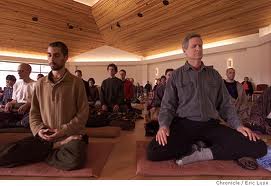Spirit Rock, pictured, is a Theravada practice center. However, we use Zen in its meaning of meditation and these practitioners are sitting in meditation.
This is a copy of an email I received June 14, 2010 from the Contact Us page of the old static html How To Practice Zen.com website, and my reply which I regret.
I am not balanced, yet seek to be. I am torn between two worlds-so it seems. But I am searching for truth in purity and inner peace to live the rest of my life. It seems these practices fit my life. People around me tell me that it appears that I am what is taught in Zen, but I have no idea what that really means. I know the definition, but not what it is to be.
I should not have replied at all. It was probably just spam anyway. After all, there was no question to answer. Still, I guessed that it might be legit and that “These practices” referred to the primary set of practices promoted by the website, the practices taught by the Buddha in the Anapanasati Sutta.
So I gave an answer to an unasked question by just repeating my understanding of sakkaya ditthi because the writer seemed to be taking “my life” a little too seriously. At the risk of sounding arrogant, I penned a reply, as follows.
We are not our bodies, we are not our minds, we are not a self with other people around us. We are not separate from pure awareness that has no beginning and no ending. If we think we own an independent self, we have a wrong view of self.
No amount of thinking will lead to that understanding of who “you” really are. All we can do is to practice daily, creating the conditions that allow awakening to pure awareness to occur. Daily practice is all we can do; pure awareness appears when the belief in self as an independent entity that has a subjective lifetime in an objective world disappears.
When we awake to the awareness that there is no self within and no world without, then we have samma ditthi, the right view of self.
Just as the wrong view of self, sakkaya ditthi, is the source of all unbalance, all suffering, so is samma ditthi, the right view of self, liberating.
We practice daily to wake up from the dream of an independent self. Pure awareness is real, the self separate from nirvana is just an illusion.
We can enjoy daily practice; it dissolves the wrong view of self and reveals pure awareness, the perfectly balanced pure awareness that is all there is. There is nothing for us to be because we are empty of self.
We can practice and let pure awareness reveal itself. We don’t have to be anything. Even the thought: “I am practicing Zen” strengthens the illusion of self. So we just practice but not to gain something for a perceived self. If we practice to gain balance, or just “to be,” we are clinging to sakkaya ditthi, the first of the ten fetters.
So we practice just to practice because that is what a Buddha does.
So my answer to the unasked question was just blah blah blah. It took me a long time to understand that the answer to every question is: Mu! Stop asking discursive questions because obviously all you want is a discursive answer. Mu! Stop thinking like that!
